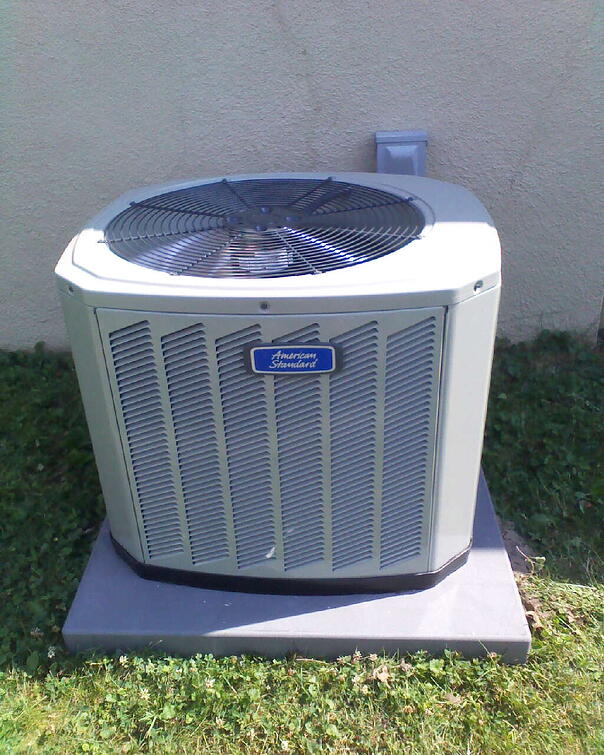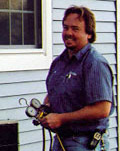
This blog is way over due. Numerous times over the years I have had people quiz me about their heat pump operation. Questions or observations such as : "Why is the air coming out of my registers not warm?", "Why does my heat pump run all the time?", "The outdoor unit is running, but the fan is not turning", "A puff of steam just came out of the outdoor unit", "My outdoor heat pump is making loud and/or weird noises." This blog will attempt to answer some of those questions. Heat pumps truly are mysterious to the uninformed.
To understand heat pumps, first, we must understand the basic operation of air conditioners. Air conditoners cool your home in the summer time by "absorbing" heat from your indoor air and expelling that heat outside. Without getting into the physics of refrigeration, lets look at the basic set up of a cooling system. There is the refrigerant, the piping to contain and transport the refrigerant, the compressor to pump the refrigerant through the system, and two coils (one inside, one outside) to exchange the heat. Indoor and outdoor fan motors are also important to draw air across the coils and allow them to exchange the heat. I am tempted to go into more detail here, but I think this will be sufficient. Anyhow, when your air conditioner is turned on by the thermostat, the compressor, and both indoor/outdoor fan motors are energized. The compressor is pumping refrigerant through the system and the fan motors are supplying air to both indoor and outdoor coils which allows the heat to be absorbed by the indoor coil, transported to the outdoor coil where it is expelled to the surrounding air. This is why the air temperature coming out of the outdoor unit is warmer than the outdoor air and vice versa, the indoor air is cooler.
Now that we have a basic idea how an air conditioner works, let us apply that knowledge to understanding heat pump operation. Imagine an air conditioner with a reverse gear in regard to the direction of the refrigerant flow. That, in a nutshell, is what a heat pump is. There is more to it than that, but this concept will suffice. When the heat pump is energized in the heating mode, the refrigerant flows in the opposite direction than it does in the cooling mode. This causes the indoor and outdoor coils to exchange functions. Now, in the heating mode, the outdoor coil is absorbing heat from the surrounding air and that heat is then discharged from the indoor coil providing heat to your home.
Next, lets look at how a heat pump is sized. Most people don't realize this, but heat pumps are sized based on your cooling needs, not heating demand. In northern climates, say Ohio for example, heating load (or demand) is higher than the cooling load. Which means that your heat pump is insufficient to supply all of your heating demand. The reason for this is that heat pumps and ducting system would have to be grossly oversized to be the only source of heat. This is unrealistic, and heat pumps are inefficient at low outdoor temperatures (i.e. single digits or less) as well. This is why we have an auxillary heat source to back up the heat pump in northern climates. This auxillary heat source, whether it be electric, LP, or oil, is usually sized to provide all of your heating needs even without the heat pump running. The reason that we don't use this auxillary source all the time is efficiency. At outdoor temperatures above 20F, most heat pumps are providing heat more efficiently than your auxillary source. At single temps and below...not so much. The heat pump capacity (tons) and efficiency (HSPF or SEER) is dependent on outdoor temperature. The lower the temperature, the lower the capacity and efficiency.
Another term used to describe the efficiency of a heat pump is the COP. This stands for Coefficient Of Performance. The best way to understand COP is this : A heat pump with a COP of 2 provides twice as much heat as electric for the same money. Or, you get the same amount of heat from a heat pump vs electric at half the cost. So, a heat pump with a COP of 3 provides the same amount of heat that you would get from an all electric heat source for one third the cost. Most heat pumps today have a COP at or near 3.0.
For more info on COP and SEER go here :
http://en.wikipedia.org/wiki/Seasonal_energy_efficiency_ratio
In the central Ohio area, your heating system should be able to warm your home to +70F with outdoor temperatures down to +5F. Most systems can do better than this. But, most heat pumps can only provide +70F indoor temperature with outdoor temperatures somewhere between +20F and +35F. With temperatures lower than that, they need the auxillary heat source to help. This brings us to a concept called the "balance point." The "balance point" is the point (outdoor temp) where the rate of heat gain provided by your heat pump is equal to the rate of heat loss by your home. Which means your heat pump is running continuously to maintain the temperature inside your home. At temperatures below the "balance point", the temperature inside your home would begin to drop. That is when your auxillary heat source kicks in to help maintain your indoor set point temperature. With all electric homes, the electric auxillary heat runs with the heat pump to provide heat as efficiently as possible. In homes that use a fossil fuel (gas, LP, or oil) for the auxillary heat source, the heat pump shuts down and the auxillary heat source takes over. While this is not ideal, it is necessary due to the fact that the indoor coil has to be after the indoor heat source with these systems (which would create havoc with your heat pump if it were to continue running). These systems which use a fossil fuel as the auxillary heat source are called "hybrid" heat pump systems.
As you can see, heat pumps will run continuously at and below your balance point. So, if your heat pump is running a lot, that doesn't mean there is something wrong with it. That said, there stills exists the possibility that may there may be a problem with the system. If your heat pump seems to run at 2F lower than your thermostat setting, and your utility bills have jumped significantly, then you could have a problem with the outdoor unit. Check to see if it is running outside when the indoor system is running. If not, then you have a problem. But, even if it is running, there could still be a problem. In this case, you may want to call your HVAC service provider and set up an appointment to have a technician look at your heat pump. Only a technician can tell you if your system is running ok or not. Be prepared for the tech to say everything is ok.
So now you know that heat pumps have a tendency to run continuously at low temps. But, that is ok. What about the air not feeling warm enough? Most heat pumps provide around 20 to 25F rise in temperature. Which means that if your set point temperature is 70F, then you can expect around 90-95F temperature coming out of your registers (some newer heat pumps can be warmer than this). Since our body temperature is 98F, 90-95F will not "feel" that warm even though the system is providing heat to your home. There may be times when the air temperature coming out of your registers feels warmer. This happens when the second stage, or auxillary heat kicks in.
"My outdoor unit is running, but the fan blade is not turning!" If you see this, your heat pump is probably ok. If the unit runs for more than 10 minutes without the fan kicking in, then you may have a problem. Another related observation : "A puff of steam just came out of the top of my heat pump!" These two observations are a normal part of your heat pump's defrost cycle. Several things happen when your heat pump enters the defrost mode. Your heat pump will enter defrost mode when sensors on the outdoor coil detect a build up of frost or ice on the coil. When this occurs, your heat pump will switch from heating mode to cooling mode (this warms up the outdoor coil to allow defrost to occur), the outdoor fan motor shuts down (to speed up the defrost process), and your auxillary heat comes on inside to temper the air. As the frost and ice begin to melt, you will see steam coming off the heat pump. This defrost process usually takes less than 10 minutes. At the end of the defrost cycle, the heat pump switches back to heating mode, the fan motor comes on (a puff of steam is usually visible), and the auxillary heat switches off (unless needed to support heat pump).
Ok, we have explored the why heat pumps seem to run continuously, why the air temperature seems cool, why the outdoor unit may be running but the out door fan motor is not, and why steam sometimes comes out of the top of the heat pump. What about strange noises coming from the heat pump? Usually, a noisy heat pump is due to stress on the compressor. Before you call your service provider, check your indoor air filter and replace/clean if necessary. Also, insure that most of your registers, dampers, and grilles are open or not blocked by anything. Good indoor airflow is crucial to a happy compressor. If after checking these the noise is still there, call your service provider to schedule an appointment to have the heat pump serviced. The technician can check both indoor and outdoor coils for proper airflow, insure that the refrigerant level is correct, and that the compressor voltage and amperage are normal. If everything checks out to be fine, then the noise is likely due to normal wear and tear of the compressor. Replacing the compressor is the only option at this point. That said, and considering the high cost of compressor replacement, most compressors can continue to run (for years in some cases) in spite of the noise.
Hopefully, this blog has been helpful and informative without being too confusing. I apologize that it is quite a bit longer than most of my blogs, but there was a lot of ground that I wanted to cover. Honestly, it could have been a lot longer ;)
If you live in or near Columbus Ohio, and need assistance with your heat pump, you can contact us at 614-837-5062.
Thanks,
Jim Harless
Minutemen Heating & Cooling, Inc.





 summer months. Columbus Ohio Heating and CoolingFurnaces are responsible for a big part of your electric and gas bill (if applicable) in the winter months. While these things greatly affect your utility charges, there are a few things you can do to save on your bill.
summer months. Columbus Ohio Heating and CoolingFurnaces are responsible for a big part of your electric and gas bill (if applicable) in the winter months. While these things greatly affect your utility charges, there are a few things you can do to save on your bill.
